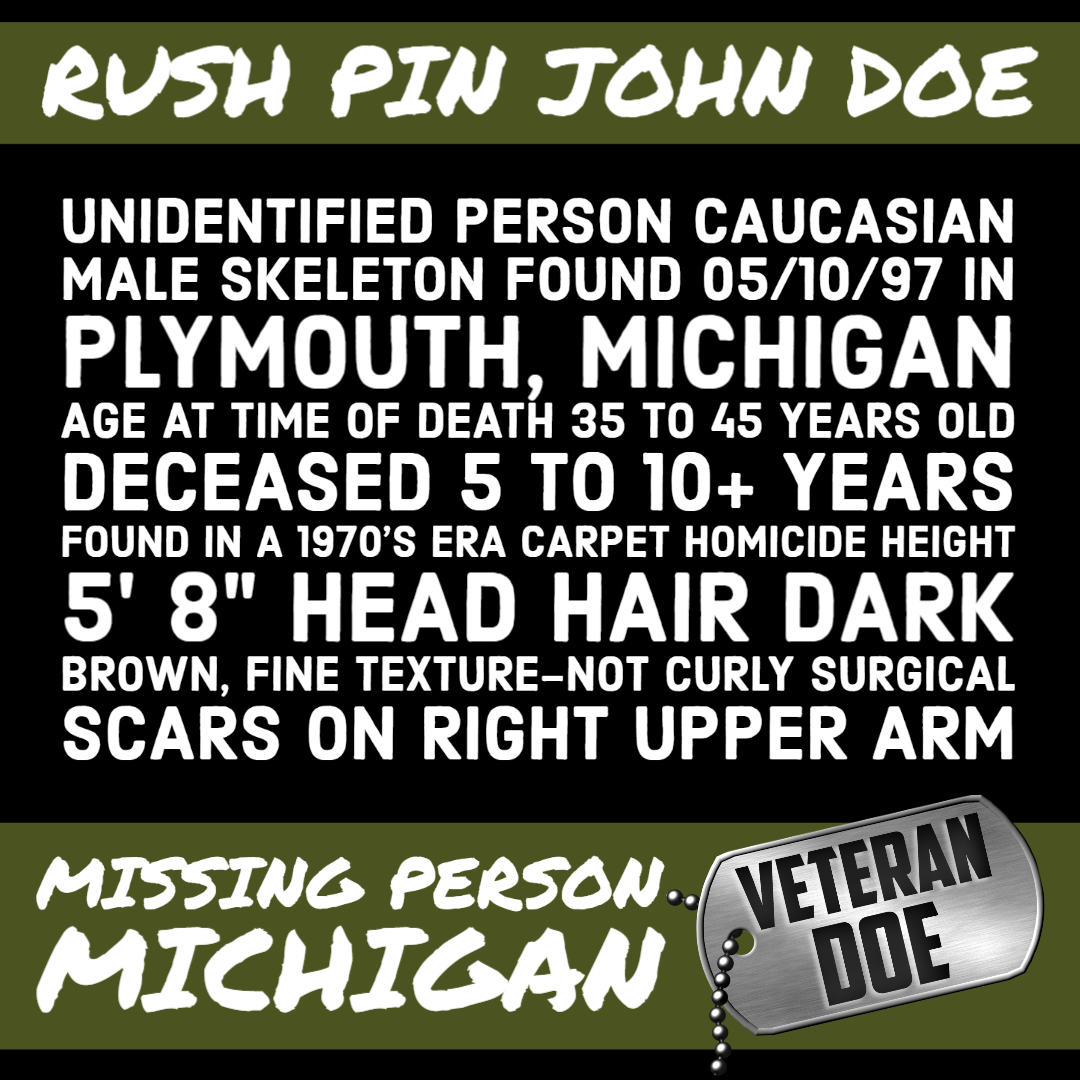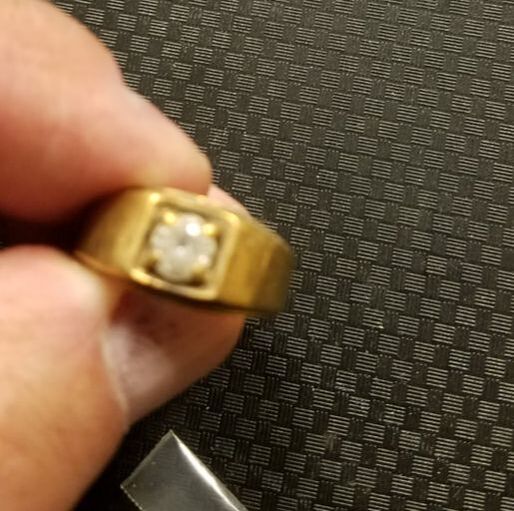‘Mystery bones’ killing still unsolved in Plymouth Twp. Daniel Bethencourt, Detroit Free Press Published 5:39 p.m. ET Oct. 4, 2015 | Updated 9:19 a.m. ET Oct. 5, 2015 Police in Plymouth Township have called the case their “mystery bones.” They are still wondering what happened to a man who was killed, wrapped in a carpet and dumped in a wooded area near railroad tracks. It’s the township’s only unsolved homicide, nearly two decades later — and police still don’t know whose bones they were. “We’re hoping somebody will remember something,” said Detective Charlie Rozum, with the township’s police department. “We’re at a standstill.” The bones were discovered on May 10, 1997. A man was surveying a wooded portion of Plymouth Township because he was thinking about buying some property nearby. He was walking near Haggerty Road, between Schoolcraft and Plymouth roads, just north of the railroad tracks. That’s when he spotted a mouse, or maybe a mole. He told police he decided, on a whim, to play with it, but the animal scurried inside a rolled-up carpet. The man pulled back the brown carpet’s corner and found a human skeleton still dressed in a blue and white striped shirt, blue shorts, and knee-high socks that read “USA 80” — memorabilia from the 1980 Olympics. The carpet had been lying there for up to a decade. So long, in fact, that grass and weeds had grown through the rolled-up carpet, according to police records. Medical examiners determined that the man had been killed by blunt force trauma to the head. A portion of his skull was bashed in. The case is fairly unusual for Plymouth Township. Rozum, one of the department’s two detectives, can recall only one homicide in seven years. “Here we have a guy that could have been laying in the field for five or 10 years before he was found, and nobody knows who he is,” said Rozum. “We don’t even have any place to start.” For years, this was most of what was known about the victim, according to police records: He was probably white and stood between 5 feet 6 inches and 5 feet 9 inches. He was between 35 and 50 years old and had a build suggesting heavy labor or athletics. He was also in fairly poor medical condition. He had a nonstandard surgical pin in his right upper arm, which could indicate a military field hospital, according to police records. His right hand and wrist had been fractured several times. He also appears to have suffered from Osgood-Schlatter disease, which causes knee pain. He appears to have worn dentures. And he wore a gold ring, which a jeweler later told Rozum was fake. For years, the case appeared stalled. DNA tests and attempts to recheck evidence have so far yielded no significant updates. But in late August of this year, Crime Stoppers put out a notice requesting clues. They got multiple tips about a homicide in West Bloomfield that took place in 1991, six years before the mystery bones were found. The case resulted in two convictions, but never led to the discovery of the body, said Curt Lawson, deputy chief of the West Bloomfield Police Department. The victim in that case was Gustav Prilepok, 56, who worked the night shift as a welder at a GM plant about a mile from where the bones were found. A coworker at that plant later told police that Prilepok served in the military at some point before working there. Prilepok was killed by members of his family. His stepson, Jan Borek, and Prilepok’s wife, Janea Prilepok, 47, later told police that Gustav was controlling and would limit the amount of money that each could have per week. He also wanted the stepson out of the house, said Detective Sgt. David St. Germaine, also with West Bloomfield Police. A day or two before Feb. 1, 1991, when the family reported Prilepok missing, he had gotten into a heated argument with his stepson in the driveway of their home on Fieldview in West Bloomfield. Then there was another altercation inside the home, Lawson said. This one turned physical: Prilepok drew a small knife and told Borek, 22, that he had to leave. Borek grabbed a fire poker and bashed his stepfather on the head, then took the knife from him and slashed him in the neck, Lawson said. Borek would later tell police that he acted in self-defense. But Borek, along with his mother, then wrapped the body up in linoleum, or maybe carpet -- Janea Prilepok told two different stories — and dumped it somewhere else. When police later examined their home, there was a section of carpet that, in a photo, looked similar to the carpet that the mystery victim was found in, according to Rozum, the detective with Plymouth Township Police. Prilepok’s wife and stepson later confessed. His stepson was convicted of second-degree murder, and his wife was convicted of an accessory charge. Both served prison terms and were then deported, possibly back to Czechoslovakia, where they were both from, Lawson said. But the whereabouts of Gustav Prilepok’s body remained a mystery. No other family members are still in the country to be interviewed. But even with all these similarities, the case was known to investigators and dismissed at the time as unlikely. The biggest difference is in the teeth. The man found in the carpet had lost most of his teeth and appeared to wear dentures. But Prilepok was thought to still have teeth a year before he died. (Police interviewed his dentist.) And even if he had lost them in the span of just one year, when the dentist had last seen him, the sockets would have needed more time to heal before the death, an expert concluded at the time. The cases have another key difference: the man in the carpet had shorts that measured 30 inches at the waist, while pants thought to belong to Prilepok and taken from his garbage measured 38 inches. According to police records, these differences were enough to “effectively eliminate the possibility” that the mystery bones were those of Prilepok. Still, within the last few months, police are trying to match blood samples from the Prilepok crime scene with DNA from a bone in Plymouth Township. These tests would not have been possible at the time. “We’re going to use the capability we have now to try to determine who this person is,” Lawson said. The results will likely take weeks, maybe a couple months. If a connection can’t be established, it’s not clear what’s next. “We’re kind of hoping that it matches,” Rozum said. Contact Daniel Bethencourt: [email protected] or 313-223-4531. Follow on Twitter at @_dbethencourt. https://www.freep.com/story/news/local/michigan/wayne/2015/10/04/mystery-bones-killing-still-unsolved-plymouth-twp/73222184/ Plymouth cold case murder still a mystery after 18 years
Published August 27, 2015NewsFOX 2 Detroit PLYMOUTH TWP - A murder mystery in Plymouth began in 1997 when police found human remains wrapped in a carpet. Two decades later the cold case continues but investigators are not giving up. Human bones, an old T-shirt and socks - they are what Plymouth Township police hope will help identify a man found near railroad tracks on Haggerty Road near Schoolcraft. "We've had people send missing us missing people," said Lt. Robert Antel. "We still have not found a match." Plymouth Township police have teamed up with Crime Stoppers of Michigan to try and get tips on the 18-year-old case. A reward of $2,500 is being offered. The bones were discovered back on May 10 of 1997. "There was a gentleman looking to purchase a piece of property," Antel said. "While he was out during a survey he saw a mouse running through a roll of carpet." Kicking the carpet, police say it unrolled revealing femurs, arm and skull pieces. The man was believed to be between 5-feet 6 and 5-feet 9 inches tall and was wearing blue shorts and white tube socks with the 1980 Olympics logo "USA 80." Police say the carpet he was wrapped in was manufactured in the 1970s. "At this point he'd be between 50 and 70 years old," Antel said. "At the time the bones were discovered they estimated him to be about 35 to 45 years old." Police ruled the man's death a homicide. "We did locate a small .357 or .38 caliber round wrapped up in the carpet with him," Antel said. Police say he died of blunt force trauma and sent the bones to Texas for DNA to be taken. The medical examiner noticed signs that the man may have had a joint disease and may have been in the Military. They cited a fracture of the man's upper right arm, where a stabilization pin was put in. "It's a pin that would be used to surgically repair a broken bone in a field hospital setting," Antel said. While police say they know it isn't much to go on and know the case is cold. "We still have an unsolved murder that we would like to get closure for some family member." https://www.fox2detroit.com/news/plymouth-cold-case-murder-still-a-mystery-after-18-years
0 Comments
Your comment will be posted after it is approved.
Leave a Reply. |
Unidentified PersonsJohn Doe and Jane Doe cases in the USA with possible connections to the US military.
Archives
November 2023
Categories
All
|
| Veteran Doe | Unidentified Persons |
Share This Page! You may be the key to bringing someone home!
Follow Veteran Doe's social media
Site Menu
Home | Top Case | Unidentified Persons | Missing Persons | Resources | News | Veteran Resources | Contact
All the case information and photos belong to the proper reporting authorities. Unique content is Copyright © 2023 VeteranDoe.com



 RSS Feed
RSS Feed